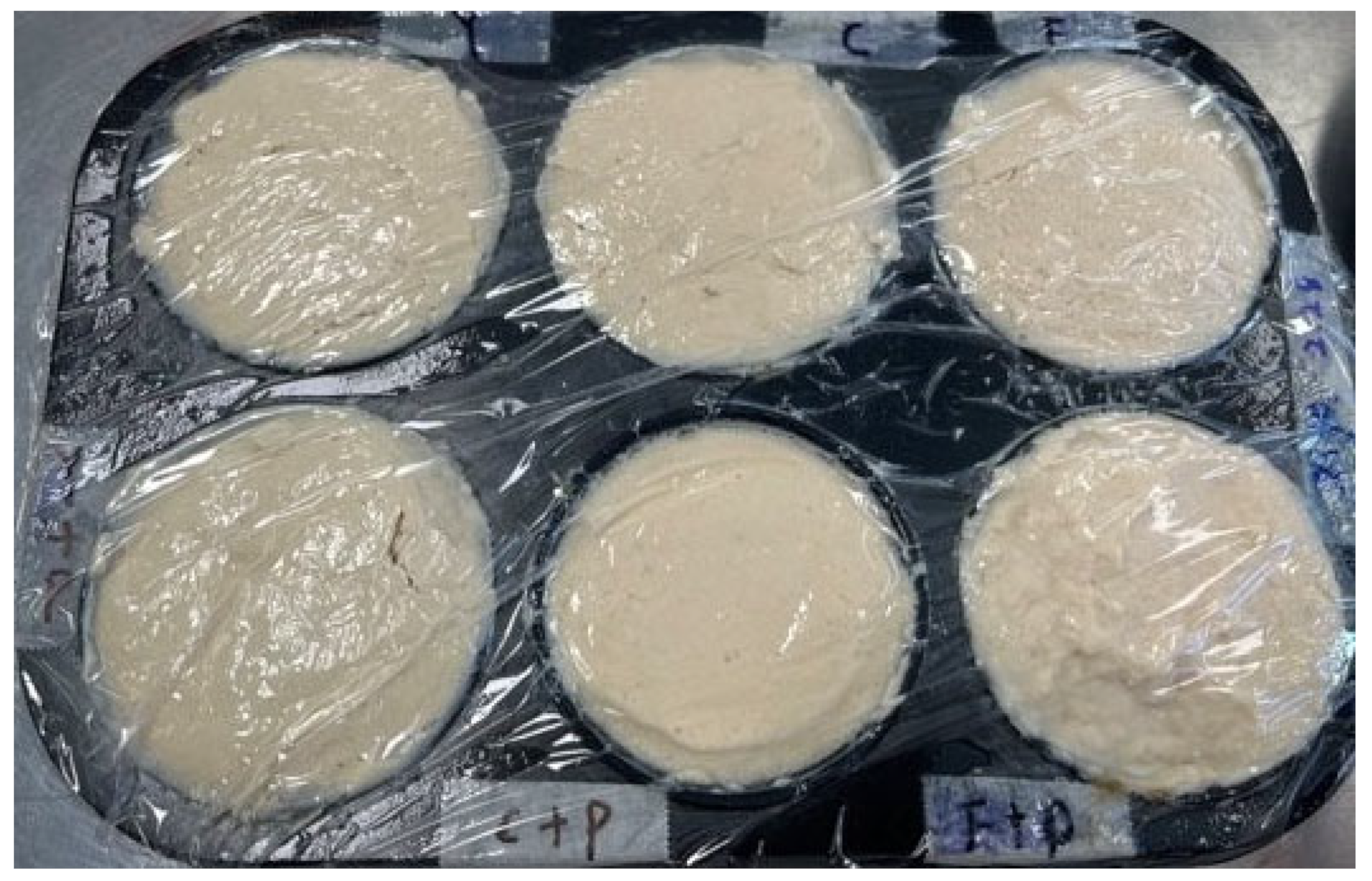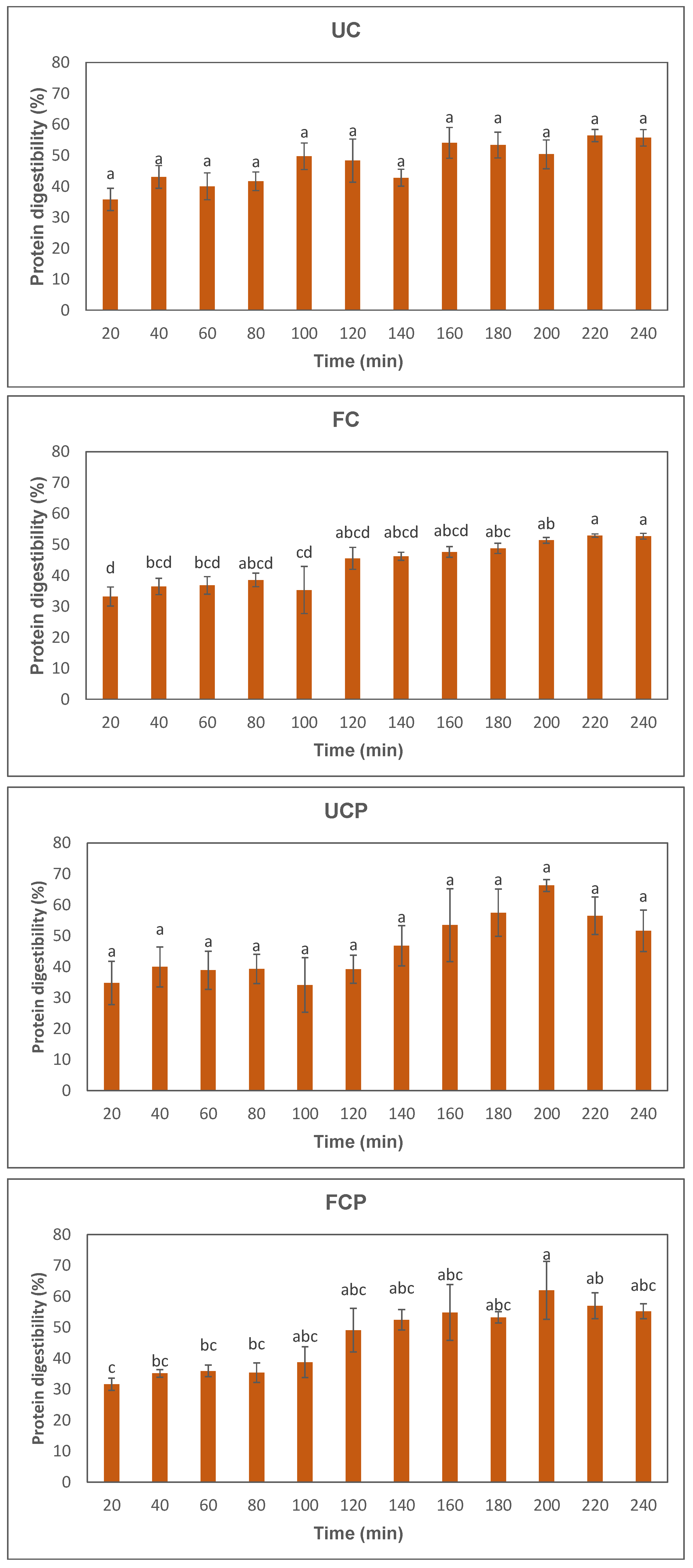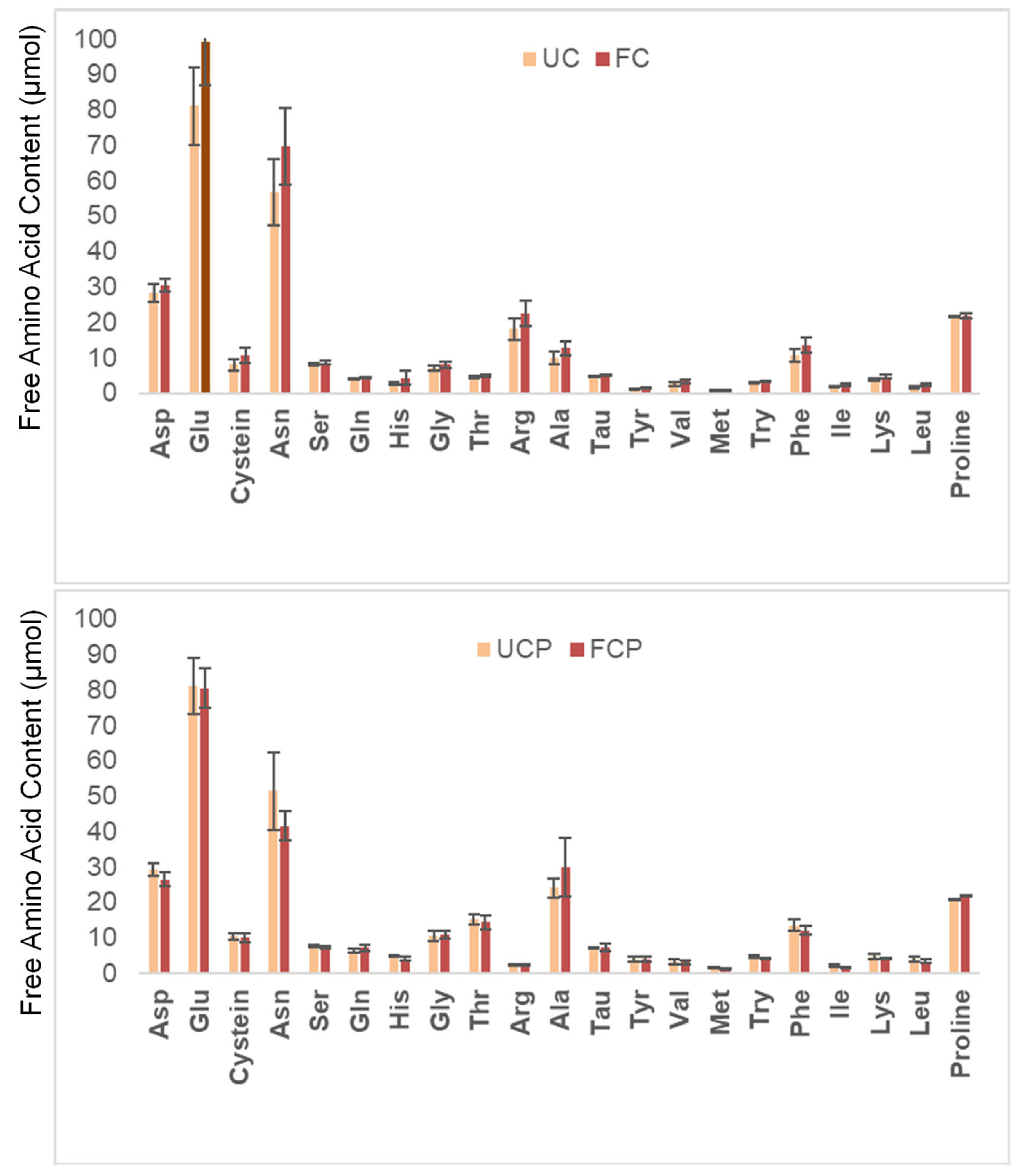Fermentation of Peanut Slurry with Lactococcus lactis Species, Leuconostoc and Propionibacterium freudenreichii subsp. globosum Enhanced Protein Digestibility
Abstract
:1. Introduction
2. Materials and Methods
2.1. Materials and Slurry Fermentation
2.2. pH
2.3. Microbial Enumeration
2.4. Protein Digestibility
2.4.1. Preparation of Sample Solutions
2.4.2. Preparation of Enzymes
2.4.3. In Vitro Protein Digestion
2.4.4. In-Vitro Protein Digestibility Evaluation
2.5. Total Amino Acids
2.6. Free Amino Acids
2.7. Texture Profile Analysis
2.8. Statistical Analysis
3. Results
3.1. Fermentability
3.2. Protein Digestibility
3.3. Total Amino Acid Profile
3.4. Free Amino Acid Profile
3.5. Texture
4. Discussion
4.1. Fermentability
4.2. Protein Digestibility
4.3. Total Amino Acid Profile
4.4. Amino Acid Profile
4.5. Texture
5. Conclusions
Author Contributions
Funding
Data Availability Statement
Acknowledgments
Conflicts of Interest
References
- Polak, R.; Phillips, E.M.; Campbell, A. Legumes: Health Benefits and Culinary Approaches to Increase Intake. Clin. Diabetes 2015, 33, 198–205. [Google Scholar] [CrossRef]
- USDA. 2018. Available online: https://fdc.nal.usda.gov/fdc-app.html#/food-details/172430/nutrients (accessed on 18 July 2023).
- Sá, A.G.A.; Moreno, Y.M.F.; Carciofi, B.A.M. Food processing for the improvement of plant proteins digestibility. Crit. Rev. Food Sci. Nutr. 2020, 60, 3367–3386. [Google Scholar] [CrossRef]
- The Ministry for Primary Industries; Plant and Food Research. The Evolution of Plant Protein. 2018. Available online: https://www.mpi.govt.nz/dmsdocument/29141-The-Evolution-of-Plant-Protein-Assessing-Consumer-Response-Report (accessed on 18 July 2023).
- Miyagi, A.; Ogaki, Y. Chemical processes in peanut under thermal treatment. J. Food Meas. Charact. 2014, 8, 305–315. [Google Scholar] [CrossRef]
- Food and Agriculture Organization of the United Nations. Dietary Protein Quality Evaluation in Human Nutrition. 2013. Available online: https://www.fao.org/ag/humannutrition/35978-02317b979a686a57aa4593304ffc17f06.pdf (accessed on 18 July 2023).
- Chen, C.C.; Shih, Y.C.; Chiou, P.W.S.; Yu, B. Evaluating Nutritional Quality of Single Stage- and Two Stage-fermented Soybean Meal. Asian-Australas. J. Anim. Sci. 2010, 23, 598–606. [Google Scholar] [CrossRef]
- Ketnawa, S.; Ogawa, Y. In vitro protein digestibility and biochemical characteristics of soaked, boiled and fermented soybeans. Sci. Rep. 2021, 11, 14257. [Google Scholar] [CrossRef]
- Griffith, L.; Castell-Perez, M.; Griffith, M. Effects of blend and processing method on the nutritional quality of weaning foods made from select cereals and legumes. Cereal Chem. 1998, 75, 105–112. [Google Scholar] [CrossRef]
- Mugula, J.; Lyimo, M. Evaluation of the nutritional quality and acceptability of sorghum-based tempe as potential weaning foods in Tanzania. Int. J. Food Sci. Nutr. 2000, 51, 269–277. [Google Scholar]
- Taye, Y.; Degu, T.; Fesseha, H.; Mathewos, M. Isolation and identification of lactic acid bacteria from cow milk and milk products. Sci. World J. 2021, 2021, 4697445. [Google Scholar] [CrossRef]
- Uraipong, C.; Zhao, J. In vitro digestion of rice bran proteins produces peptides with potent inhibitory effects on -glucosidase and angiotensin I converting enzyme. J. Sci. Food Agric. 2018, 98, 758–766. [Google Scholar] [CrossRef]
- Almeida, C.C.; Monteiro, M.L.G.; da Costa-Lima, B.R.C.; Alvares, T.S.; Conte-Junior, C.A. In vitro digestibility of commercial whey protein supplements. LWT-Food Sci. Technol. 2015, 61, 7–11. [Google Scholar] [CrossRef]
- Chen, W.; Chiu, H.T.; Feng, Z.; Maes, E.; Serventi, L. Effect of spray-drying and freeze-drying on the composition, physical properties, and sensory quality of pea processing water (Liluva). Foods 2021, 10, 1401. [Google Scholar] [CrossRef]
- Makarova, K.; Slesarev, A.; Wolf, Y.; Sorokin, A.; Mirkin, B.; Koonin, E.; Pavlov, A.; Pavlova, N.; Karamychev, V.; Polouchine, N.; et al. Comparative genomics of the lactic acid bacteria. Proc. Natl. Acad. Sci. USA 2006, 103, 15611–15616. [Google Scholar] [CrossRef]
- Hsu, S.T.; Yang, S.T. Propionic-acid fermentation of lactose by propionibacterium-acidipropionici—Effects of pH. Biotechnol. Bioeng. 1991, 38, 571–578. [Google Scholar] [CrossRef]
- Dank, A.; Mastrigt, O.V.; Boeren, S.; Lillevang, S.K.; Abee, T.; Smid, E.J. Propionibacterium freudenreichii thrives in microaerobic conditions by complete oxidation of lactate to CO2. Environ. Microbiol. 2021, 23, 3116–3129. [Google Scholar] [CrossRef]
- Basha, S.M. Soluble sugar composition of peanut seed. J. Agric. Food Chem. 1992, 40, 780–783. [Google Scholar] [CrossRef]
- Golomb, B.L.; Marco, M.L. Lactococcus lactis metabolism and gene expression during growth on plant tissues. J. Bacteriol. 2015, 197, 371–381. [Google Scholar] [CrossRef]
- Narisetty, V.; Zhang, L.; Zhang, J.; Lin, C.S.K.; Tong, Y.W.; Show, P.L.; Bhatia, S.K.; Misra, A.; Kumar, V. Fermentative production of 2, 3-Butanediol using bread waste–A green approach for sustainable management of food waste. Bioresour. Technol. 2022, 358, 127381. [Google Scholar] [CrossRef]
- De Faveri, D.; Torre, P.; Molinari, F.; Perego, P.; Converti, A. Carbon material balances and bioenergetics of 2, 3-butanediol bio-oxidation by Acetobacter hansenii. Enzyme Microb. Technol. 2003, 33, 708–719. [Google Scholar] [CrossRef]
- Bonku, R.; Yu, J. Health aspects of peanuts as an outcome of its chemical composition. Food Sci. Hum. Wellness 2020, 9, 21–30. [Google Scholar] [CrossRef]
- Settaluri, V.S.; Kandala, C.V.K.; Puppala, N.; Sundaram, J. Peanuts and their nutritional aspects—Review. Food Nutr. Sci. 2012, 3, 25267. [Google Scholar] [CrossRef]
- Singh, B.; Singh, U. Peanut as a source of protein for human foods. Plant Foods Hum. Nutr. 1991, 41, 165–177. [Google Scholar] [CrossRef]
- Chavan, M.; Gat, Y.; Harmalkar, M.; Waghmare, R. Development of non-dairy fermented probiotic drink based on germinated and ungerminated cereals and legume. LWT 2018, 91, 339–344. [Google Scholar] [CrossRef]
- Wang, S.; Chelikani, V.; Serventi, L. Evaluation of chickpea as alternative to soy in plant-based beverages, fresh and fermented. LWT 2018, 97, 570–572. [Google Scholar] [CrossRef]
- Anggraeni, S.L.; Jayus, J.; Ratnadewi, A.; Nurhayati, N. Edamame protein hydrolysis using Lactococcus lactis, Lactobacillus bulgaricus and Lactobacillus paracasei produce short peptides with higher antioxidant potential. Biodiversitas 2022, 23, 7. [Google Scholar] [CrossRef]
- Rizzello, C.; Coda, R.; Wang, Y.; Verni, M.; Kajala, I.; Katina, K.; Laitila, A. Characterization of indigenous Pediococcus pentosaceus, Leuconostoc kimchii, Weissella cibaria and Weissella confusa for faba bean bioprocessing. Int. J. Food Microbiol. 2019, 302, 24–34. [Google Scholar] [CrossRef]
- Cooper, R.K.; Collins, E.B. Influences of Temperature on Growth of Leuconostoc cremoris. J. Dairy Sci. 1978, 61, 1085–1088. [Google Scholar] [CrossRef]
- Enan, G.; Abdel-Shafi, S.; Ouda, S.; Negm, S. Novel antibacterial activity of lactococcus lactis subspecies lactis z11 isolated from zabady. J. Biomed. Sci. 2013, 9, 174–180. [Google Scholar]
- Rattray, F.P.; Eppert, I. Secondary cultures. In Encyclopedia of Dairy Sciences, 2nd ed.; Elsevier: Amsterdam, The Netherlands, 2022; pp. 567–573. [Google Scholar] [CrossRef]
- Riedel, K.H.J.; Britz, T.J. Propionibacterium species-diversity IN anaerobic digesters. Biodivers. Conserv. 1993, 2, 400–411. [Google Scholar] [CrossRef]
- Liu, K.; Liu, Y.; Chen, F. Effect of storage temperature on lipid oxidation and changes in nutrient contents in peanuts. Food Sci. Nutr. 2019, 7, 2280–2290. [Google Scholar] [CrossRef]
- Aburjaile, F.F.; Rohmer, M.; Parrinello, H.; Maillard, M.B.; Beaucher, E.; Henry, G.; Nicolas, A.; Madec, M.N.; Thierry, A.; Parayre, S.; et al. Adaptation of Propionibacterium freudenreichii to long-term survival under gradual nutritional shortage. BMC Genom. 2016, 17, 1007. [Google Scholar] [CrossRef]
- Ninomiya, K. Science of umami taste: Adaptation to gastronomic culture. Flavour 2015, 4, 13. [Google Scholar] [CrossRef]
- Zhang, J.; Zhao, M.; Su, G.; Lin, L. Identification and taste characteristics of novel umami and umami-enhancing peptides separated from peanut protein isolate hydrolysate by consecutive chromatography and UPLC–ESI–QTOF–MS/MS. Food Chem. 2019, 278, 674–682. [Google Scholar] [CrossRef]
- Gal, J. The discovery of stereoselectivity at biological receptors: Arnaldo Piutti and the taste of the asparagine enantiomers—History and analysis on the 125th anniversary. Chirality 2012, 24, 959–976. [Google Scholar] [CrossRef]
- Sun, Q.; Xiong, C.S.L. Functional and pasting properties of pea starch and peanut protein isolate blends. Carbohydr. Polym. 2014, 101, 1134–1139. [Google Scholar] [CrossRef]
- Wu, H.; Wang, Q.; Ma, T.; Ren, J. Comparative studies on the functional properties of various protein concentrate preparations of peanut protein. Food Res. Int. 2009, 42, 343–348. [Google Scholar] [CrossRef]
- Emkani, M.; Oliete, B.; Saurel, R. Effect of lactic acid fermentation on legume protein properties, a review. Fermentation 2022, 8, 244. [Google Scholar] [CrossRef]
- Ge, J.; Sun, C.X.; Sun, M.; Zhang, Y.; Fang, Y. Introducing panda bean (Vigna umbellata (Thunb.) Ohwi et Ohashi) protein isolate as an alternative source of legume protein: Physicochemical, functional and nutritional characteristics. Food Chem. 2022, 388, 133016. [Google Scholar] [CrossRef]
- Dank, A.; Biel, G.; Abee, T.; Smid, E.J. Microaerobic metabolism of lactate and propionate enhances vitamin B12 production in Propionibacterium freudenreichii. Microb. Cell Factories 2022, 21, 225. [Google Scholar] [CrossRef]




| Fermentability | UC | FC | UCP | FCP |
|---|---|---|---|---|
| pH | 6.78 ± 0.03 a | 4.74 ± 0.06 b | 6.67 ± 0.04 a | 4.70 ± 0.06 b |
| Microbial Enumeration (CFU/g) | 6 × 103 | TMC 1 | 1 × 103 | TMC 1 |
| Texture Profile | UC | FC | UCP | FCP |
|---|---|---|---|---|
| Hardness (g) | 220 ± 108 a | 52.8 ± 4.8 b | 141 ± 47 ab | 100 ± 3 ab |
| Adhesiveness (g·mm) | 82.9 ± 19.7 b | 88.5 ± 16 b | 299 ±175 a | 173 ± 3 ab |
Disclaimer/Publisher’s Note: The statements, opinions and data contained in all publications are solely those of the individual author(s) and contributor(s) and not of MDPI and/or the editor(s). MDPI and/or the editor(s) disclaim responsibility for any injury to people or property resulting from any ideas, methods, instructions or products referred to in the content. |
© 2023 by the authors. Licensee MDPI, Basel, Switzerland. This article is an open access article distributed under the terms and conditions of the Creative Commons Attribution (CC BY) license (https://creativecommons.org/licenses/by/4.0/).
Share and Cite
Saizen, A.; Stipkovits, L.; Muto, Y.; Serventi, L. Fermentation of Peanut Slurry with Lactococcus lactis Species, Leuconostoc and Propionibacterium freudenreichii subsp. globosum Enhanced Protein Digestibility. Foods 2023, 12, 3447. https://doi.org/10.3390/foods12183447
Saizen A, Stipkovits L, Muto Y, Serventi L. Fermentation of Peanut Slurry with Lactococcus lactis Species, Leuconostoc and Propionibacterium freudenreichii subsp. globosum Enhanced Protein Digestibility. Foods. 2023; 12(18):3447. https://doi.org/10.3390/foods12183447
Chicago/Turabian StyleSaizen, Ayana, Letitia Stipkovits, Yukiyo Muto, and Luca Serventi. 2023. "Fermentation of Peanut Slurry with Lactococcus lactis Species, Leuconostoc and Propionibacterium freudenreichii subsp. globosum Enhanced Protein Digestibility" Foods 12, no. 18: 3447. https://doi.org/10.3390/foods12183447
APA StyleSaizen, A., Stipkovits, L., Muto, Y., & Serventi, L. (2023). Fermentation of Peanut Slurry with Lactococcus lactis Species, Leuconostoc and Propionibacterium freudenreichii subsp. globosum Enhanced Protein Digestibility. Foods, 12(18), 3447. https://doi.org/10.3390/foods12183447






